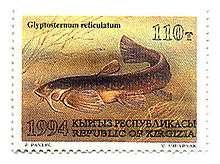Glyptosternon
Glyptosternon is a genus of sisorid catfishes native to Asia.
| Glyptosternon | |
|---|---|
 | |
| Glyptosternon reticulatum | |
| Scientific classification | |
| Kingdom: | Animalia |
| Phylum: | Chordata |
| Class: | Actinopterygii |
| Order: | Siluriformes |
| Family: | Sisoridae |
| Tribe: | Glyptosternina |
| Genus: | Glyptosternon McClelland, 1842 |
| Type species | |
| Glyptosternon reticulatus McClelland, 1842 | |
| Synonyms | |

Species
There are currently five recognized species in this genus:[1]
- Glyptosternon akhtari Silas, 1952
- Glyptosternon maculatum (Regan, 1905)
- Glyptosternon malaisei Rendahl (de) & Vestergren, 1941
- Glyptosternon reticulatum McClelland, 1842 (Turkestan catfish)
- Glyptosternon oschanini Herzenstein, 1889 (Turkestan catfish)
Distribution
Glyptosternon species are distributed in Indus drainage in Afghanistan, Pakistan, India (in the state of Jammu and Kashmir), Uzbekistan, Tajikistan, Kyrgyzstan and western China, east to the Irrawaddy drainage in Burma.[2] G. akharti is from the Bamian River of the Oxus Watershed of the Indus drainage in Afghanistan. G. maculatum is found in the Brahmaputra drainage of India and China. G. malaisei, known only from the type, is from the Irrawaddy drainage in Burma. G. reticulatum is from the Indus drainage including Afghanistan, Pakistan, Kashmir, and western China.[2] G. oschanini is known from the Upper Syr Darya and probably Amu Darya in Kyrgyzstan and Tajikistan [3]
Description
Exostoma is distinguished by having the combination of an interrupted groove behind the lip (post-labial groove), the gill openings extending onto the underside (venter), homodont dentition with pointed teeth in both jaws, a crescent-shaped tooth patch in the upper jaw, and 10–12 branched pectoral rays.[2] The head is depressed with a broadly rounded snout. The body is elongate and flattened ventrally to the pelvic fins. The eyes are minute, dorsally located, and under the skin (subcutaneous). The lips are thick, fleshy, and papillated. The teeth in both jaws are pointed and the tooth patches in the upper jaw are joined, forming a band produced posteriorly at sides (crescent-shaped). The paired fins are plaited to form an adhesive apparatus.[2]
G. maculatum and G. reticulatum grow to between 24.0–25.5 centimetres (9.4–10.0 inches).[4][5] G. malaisei has a maximum recorded length of 7.0 cm TL.[6]
Ecology
G. maculatum is found in mountain rapids.[4] G. reticulatum is found in rivers and streams under stones and rocks. It feeds mainly on invertebrates, especially insect larvae.[5]
References
- Froese, Rainer and Pauly, Daniel, eds. (2012). Species of Glyptosternon in FishBase. February 2012 version.
- Thomson, Alfred W.; Page, Lawrence M. (2006). "Genera of the Asian Catfish Families Sisoridae and Erethistidae (Teleostei: Siluriformes)" (PDF). Zootaxa. 1345: 1–96. doi:10.11646/zootaxa.1345.1.1.
- Thoni, Ryan J.; Simonov, Evgeniy; Artaev, Oleg; Asylbaeva, Shaigul; Aibek, Sergek Uulu; Levin, Boris A. (2017). "A century in synonymy: Molecular and morphological evidence for the revalidation of Glyptosternon osсhanini (Herzenstein, 1889) (Actinopterygii: Sisoridae)". Zootaxa. 4277 (3): 435. doi:10.11646/zootaxa.4277.3.8. PMID 30308643.
- Froese, Rainer and Pauly, Daniel, eds. (2007). "Glyptosternon maculatum" in FishBase. July 2007 version.
- Froese, Rainer and Pauly, Daniel, eds. (2007). "Glyptosternon reticulatum" in FishBase. July 2007 version.
- Froese, Rainer and Pauly, Daniel, eds. (2007). "Glyptosternon malaisei" in FishBase. July 2007 version.